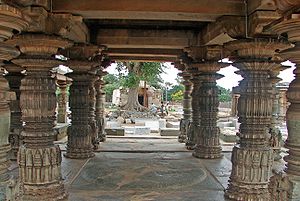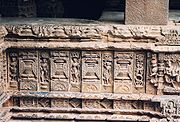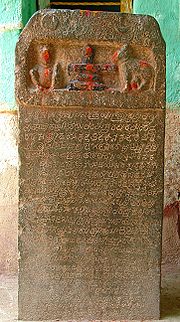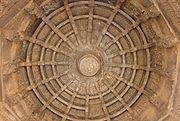
Koppal
Encyclopedia
Koppal is a town in Koppal district
in the India
n state
of Karnataka
. Koppal is surrounded on three sides by hillocks and was an important town in the history of Karnataka, popularly known as Kopana Nagar. It contains historical locations such as Koppal Fort, Gavimath (a religious shrine) and the Maley Mallappa Temple.
Koppal district has a population
of 1,391,292, roughly equal to the nation of Swaziland
or the US state of Hawaii
. This gives it a ranking of 350th in India (out of a total of 640
).
The district has a population density of 250 PD/sqkm . Its population growth rate
over the decade 2001-2011 was 16.32 %. Koppal has a sex ratio
of 983 females
for every 1000 males, and a literacy rate
of 67.28 %.
 Most notable of the many buildings dating from this period are the Mahadeva Temple at Itagi in the Koppal district, the Kasivisvesvara Temple at Lakkundi
Most notable of the many buildings dating from this period are the Mahadeva Temple at Itagi in the Koppal district, the Kasivisvesvara Temple at Lakkundi
in the Gadag district
, and the Mallikarjuna Temple at Kuruvatti and the Kallesvara Temple at Bagali, both in the Davangere district. Other monuments notable for their craftsmanship include the Siddhesvara Temple at Haveri
in the Haveri district
, the Amrtesvara Temple at Annigeri in the Dharwad district
, the Sarasvati Temple in Gadag, and the Dodda Basappa Temple at Dambal
, both in the Gadag district
.

 The Mahadeva temple at Itagi dedicated to Shiva is among the larger temples built by the Western Chalukyas and perhaps the most famous. Inscriptions hail it as the 'Emperor among temples'. Here, the main temple, the sanctum of which has a linga, is surrounded by thirteen minor shrines, each with its own linga. The temple has two other shrines, dedicated to Murthinarayana and Chandraleshwari, parents of Mahadeva, the Chalukya commander who consecrated the temple in 1112 CE.
The Mahadeva temple at Itagi dedicated to Shiva is among the larger temples built by the Western Chalukyas and perhaps the most famous. Inscriptions hail it as the 'Emperor among temples'. Here, the main temple, the sanctum of which has a linga, is surrounded by thirteen minor shrines, each with its own linga. The temple has two other shrines, dedicated to Murthinarayana and Chandraleshwari, parents of Mahadeva, the Chalukya commander who consecrated the temple in 1112 CE.
Soapstone is found in abundance in the regions of Haveri, Savanur, Byadgi, Motebennur and Hangal. The great archaic sandstone building blocks used by the Badami Chalukyas were superseded with smaller blocks of soapstone and with smaller masonry.
The first temple to be built from this material was the Amrtesvara Temple in Annigeri in the Dharwad district in 1050 CE. This building was to be the prototype for later, more articulated structures such as the Mahadeva Temple at Itagi.
The 11th-century temple-building boom continued in the 12th century with the addition of new features. The Mahadeva Temple at Itagi and the Siddhesvara Temple in Haveri are standard constructions incorporating these developments. Based on the general plan of the Amrtesvara Temple at Annigeri, the Mahadeva Temple was built in 1112 CE and has the same architectural components as its predecessor. There are however differences in their articulation; the sala roof (roof under the finial
of the superstructure) and the miniature towers on pilaster
s are chiseled instead of moulded.
 The difference between the two temples, built fifty years apart, is the more rigid modelling and decoration found in many components of the Mahadeva Temple. The voluptuous carvings of the 11th century were replaced with a more severe chiselling.
The difference between the two temples, built fifty years apart, is the more rigid modelling and decoration found in many components of the Mahadeva Temple. The voluptuous carvings of the 11th century were replaced with a more severe chiselling.
World Heritage sites. Other well known temples are the Parameshwara temple at Konnur, Brahmadeva temple at Savadi, the Settavva, Kontigudi II, Jadaragudi and Ambigeragudi temples at Aihole
, Mallikarjuna temple at Ron, Andhakeshwara temple at Huli, Someshwara temple at Sogal, Jain temples at Lokapura, Navalinga Temple
at Kuknur, Kumaraswamy temple at Sandur, at Shirival in Gulbarga and the Trikunteshwara temple at Gadag which was later expanded by Kalyani Chalukyas. Archeological study of these temples show some have the stellar (multigonal) plan later to be used profusely by the Hoysalas of Belur
and Halebidu
. One of the richest traditions in Indian architecture took shape in the Deccan during this time and one writer calls it Karnata dravida style as opposed to traditional Dravida style.
 In the year 1897 Balakrishna Hari Chapekar, one of the three Chapekar brothers
In the year 1897 Balakrishna Hari Chapekar, one of the three Chapekar brothers
, involved in the shooting of Ryand and Ayrest in Pune, was arrested by one Mr. Stephenson in the district of Raichur. For this arrest the Hyerabad Police received a reward from the Government of Bombay. Balakrishna Hari Chapekar seems to have stayed for more than six months in the hills between Koppal and Gangavathi which were then in the district of Raicur. He attracted a great deal of sympathy from the local people. In spite of the enquiries made by the Government of Bombay
, the Hyderabad
Police refused to reveal the names of the informers who were responsible for the arrest of Balakrishna Hari Chapekar. Their names have not been mentioned, in the statement of the distribution of rewards. This demonstrates the strong sympathy among the local population for the Chapekars and how deeply were the informers afraid of the revelation of their names. The arrest of Chapekar, which took place at the end of 1898, reveals the movements of Maratha
revolutionaries in the State of Hyderabad.
Koppal district
Koppal district is an administrative district in the state of Karnataka in India. In the past Koppal was referred to as 'Kopana Nagara'. Hampi, a World heritage center, covers some areas of Koppal District. It is situated approximately 38 km away...
in the India
India
India , officially the Republic of India , is a country in South Asia. It is the seventh-largest country by geographical area, the second-most populous country with over 1.2 billion people, and the most populous democracy in the world...
n state
States and territories of India
India is a federal union of states comprising twenty-eight states and seven union territories. The states and territories are further subdivided into districts and so on.-List of states and territories:...
of Karnataka
Karnataka
Karnataka , the land of the Kannadigas, is a state in South West India. It was created on 1 November 1956, with the passing of the States Reorganisation Act and this day is annually celebrated as Karnataka Rajyotsava...
. Koppal is surrounded on three sides by hillocks and was an important town in the history of Karnataka, popularly known as Kopana Nagar. It contains historical locations such as Koppal Fort, Gavimath (a religious shrine) and the Maley Mallappa Temple.
Demographics
According to the 2011 census2011 census of India
The 15th Indian National census was conducted in two phases, houselisting and population enumeration. Houselisting phase began on April 1, 2010 and involved collection of information about all buildings...
Koppal district has a population
Demographics of India
The demographics of India are inclusive of the second most populous country in the world, with over 1.21 billion people , more than a sixth of the world's population. Already containing 17.5% of the world's population, India is projected to be the world's most populous country by 2025, surpassing...
of 1,391,292, roughly equal to the nation of Swaziland
Swaziland
Swaziland, officially the Kingdom of Swaziland , and sometimes called Ngwane or Swatini, is a landlocked country in Southern Africa, bordered to the north, south and west by South Africa, and to the east by Mozambique...
or the US state of Hawaii
Hawaii
Hawaii is the newest of the 50 U.S. states , and is the only U.S. state made up entirely of islands. It is the northernmost island group in Polynesia, occupying most of an archipelago in the central Pacific Ocean, southwest of the continental United States, southeast of Japan, and northeast of...
. This gives it a ranking of 350th in India (out of a total of 640
Districts of India
A district is an administrative division of an Indian state or territory. Districts are further subdivided, in some cases into Sub-Divisions, and otherwise directly into tehsils or talukas.District officials include:...
).
The district has a population density of 250 PD/sqkm . Its population growth rate
Family planning in India
Family planning in India is based on efforts largely sponsored by the Indian government. In the 1965-2009 period, contraceptive usage has more than tripled and the fertility rate has more than halved , but the national fertility rate is still high enough to cause long-term population growth...
over the decade 2001-2011 was 16.32 %. Koppal has a sex ratio
Sex ratio
Sex ratio is the ratio of males to females in a population. The primary sex ratio is the ratio at the time of conception, secondary sex ratio is the ratio at time of birth, and tertiary sex ratio is the ratio of mature organisms....
of 983 females
Women in India
The status of women in India has been subject to many great changes over the past few millennia. From equal status with men in ancient times through the low points of the medieval period, to the promotion of equal rights by many reformers, the history of women in India has been eventful...
for every 1000 males, and a literacy rate
Literacy in India
Literacy in India is key for socio-economic progress, and the Indian literacy rate grew to 74.04% in 2011 from 12% at the end of British rule in 1947. Although this was a greater than sixfold improvement, the level is well below the world average literacy rate of 84%, and India currently has the...
of 67.28 %.
Tourist attractions

Lakkundi
Lakkundi in Gadag District of Karnataka is a tiny village on the way to Hampi from Hubli. Lakkundi 11 km from Gadag in the east...
in the Gadag district
Gadag District
Gadag District had a population of 971,952 of which 35.21% was urban as of 2001. Population increased 13.14% in the decade 1991-2001. The District is bounded on the north by Bagalkot District, on the east by Koppal District, on the southeast by Bellary District, on the southwest by Haveri...
, and the Mallikarjuna Temple at Kuruvatti and the Kallesvara Temple at Bagali, both in the Davangere district. Other monuments notable for their craftsmanship include the Siddhesvara Temple at Haveri
Haveri
Haveriis a town in Karnataka. It is the administrative headquarters of Haveri District. The name Haveri is derived from the Kannada words havu and keri, which means place of snakes. Haveri is famous for its cardamom garlands. It is said that Haveri had around 1000 maths in ancient days. One of...
in the Haveri district
Haveri District
Haveri is a district in the state of Karnataka, India with the potential to become a tourist hub. As of 2001, it had a population of 1,439,116 of which 20.78% were urban residents.-Tourism:Examples of tourist attractions in the district:...
, the Amrtesvara Temple at Annigeri in the Dharwad district
Dharwad District
Dharwad District is an administrative district of the state of Karnataka in southern India. Dharwad is the cultural headquarters of North Karnataka....
, the Sarasvati Temple in Gadag, and the Dodda Basappa Temple at Dambal
Dambal
Dambal is a village in the Gadag district of the state of Karnataka, India. It was an ancient center of Buddhism and remained so as late as the 12th century.Dambal is at an elevation of 590 metres and its population is 21,096.-History:...
, both in the Gadag district
Gadag District
Gadag District had a population of 971,952 of which 35.21% was urban as of 2001. Population increased 13.14% in the decade 1991-2001. The District is bounded on the north by Bagalkot District, on the east by Koppal District, on the southeast by Bellary District, on the southwest by Haveri...
.
The Mahadeva Temple


Soapstone is found in abundance in the regions of Haveri, Savanur, Byadgi, Motebennur and Hangal. The great archaic sandstone building blocks used by the Badami Chalukyas were superseded with smaller blocks of soapstone and with smaller masonry.
The first temple to be built from this material was the Amrtesvara Temple in Annigeri in the Dharwad district in 1050 CE. This building was to be the prototype for later, more articulated structures such as the Mahadeva Temple at Itagi.
The 11th-century temple-building boom continued in the 12th century with the addition of new features. The Mahadeva Temple at Itagi and the Siddhesvara Temple in Haveri are standard constructions incorporating these developments. Based on the general plan of the Amrtesvara Temple at Annigeri, the Mahadeva Temple was built in 1112 CE and has the same architectural components as its predecessor. There are however differences in their articulation; the sala roof (roof under the finial
Finial
The finial is an architectural device, typically carved in stone and employed decoratively to emphasize the apex of a gable or any of various distinctive ornaments at the top, end, or corner of a building or structure. Smaller finials can be used as a decorative ornament on the ends of curtain rods...
of the superstructure) and the miniature towers on pilaster
Pilaster
A pilaster is a slightly-projecting column built into or applied to the face of a wall. Most commonly flattened or rectangular in form, pilasters can also take a half-round form or the shape of any type of column, including tortile....
s are chiseled instead of moulded.

Kuknur
In Karnataka their most famous temples are the Kashivishvanatha temple and the Jain Narayana temple at Pattadakal, both of which are UNESCOUNESCO
The United Nations Educational, Scientific and Cultural Organization is a specialized agency of the United Nations...
World Heritage sites. Other well known temples are the Parameshwara temple at Konnur, Brahmadeva temple at Savadi, the Settavva, Kontigudi II, Jadaragudi and Ambigeragudi temples at Aihole
Aihole
Aihole is a temple complex in the Bagalkot district of Karnataka, India. It is a very popular tourist spot in north Karnataka. It lies to the east of Pattadakal, along the Malaprabha River, while Badami is to the west of both....
, Mallikarjuna temple at Ron, Andhakeshwara temple at Huli, Someshwara temple at Sogal, Jain temples at Lokapura, Navalinga Temple
Navalinga Temple
The Navalinga temple was built in the 9th century, during the reign of King Amoghavarsha I or his son Krishna II of the Rashtrakuta Dynasty. The temple is located in the town of Kukkanur , north of Itagi in Koppal district and east of Gadag in Karnataka state, India...
at Kuknur, Kumaraswamy temple at Sandur, at Shirival in Gulbarga and the Trikunteshwara temple at Gadag which was later expanded by Kalyani Chalukyas. Archeological study of these temples show some have the stellar (multigonal) plan later to be used profusely by the Hoysalas of Belur
Belur
Belur may refer to any of the following:* Belur, Karnataka, town in Karnataka, India* Belur, West Bengal, India, a locality on the west bank of the Hooghly River* Belur Math, the religious abbey located in Belur, West Bengal, India...
and Halebidu
Halebidu
Halebidu is located in Hassan District, Karnataka, India. Halebidu was the regal capital of the Hoysala Empire in the 12th century. It is home to one of the best examples of Hoysala architecture in the ornate Hoysaleswara and Kedareswara temples. Halebidu literally means ruined city...
. One of the richest traditions in Indian architecture took shape in the Deccan during this time and one writer calls it Karnata dravida style as opposed to traditional Dravida style.
Hideout for Balkrishna Hari Chapekar

Chapekar brothers
The Chapekar brothers alternatively spelt as Caphekar or Chaphekar , Damodar Hari, Balkrishna Hari and Vasudeo Hari belonged to Chinchwad, then a village, near the former Peshwa capital Pune, in the state of Maharashtra, India.In late 1896, Pune was hit by bubonic plague; by the end of February...
, involved in the shooting of Ryand and Ayrest in Pune, was arrested by one Mr. Stephenson in the district of Raichur. For this arrest the Hyerabad Police received a reward from the Government of Bombay. Balakrishna Hari Chapekar seems to have stayed for more than six months in the hills between Koppal and Gangavathi which were then in the district of Raicur. He attracted a great deal of sympathy from the local people. In spite of the enquiries made by the Government of Bombay
Bombay Presidency
The Bombay Presidency was a province of British India. It was established in the 17th century as a trading post for the English East India Company, but later grew to encompass much of western and central India, as well as parts of post-partition Pakistan and the Arabian Peninsula.At its greatest...
, the Hyderabad
Hyderabad State
-After Indian independence :When India gained independence in 1947 and Pakistan came into existence in 1947, the British left the local rulers of the princely states the choice of whether to join one of the new dominions or to remain independent...
Police refused to reveal the names of the informers who were responsible for the arrest of Balakrishna Hari Chapekar. Their names have not been mentioned, in the statement of the distribution of rewards. This demonstrates the strong sympathy among the local population for the Chapekars and how deeply were the informers afraid of the revelation of their names. The arrest of Chapekar, which took place at the end of 1898, reveals the movements of Maratha
Marathi people
The Marathi people or Maharashtrians are an Indo-Aryan ethnic group, that inhabit the Maharashtra region and state of western India. Their language Marathi is part of the southern group of Indo-Aryan languages...
revolutionaries in the State of Hyderabad.

